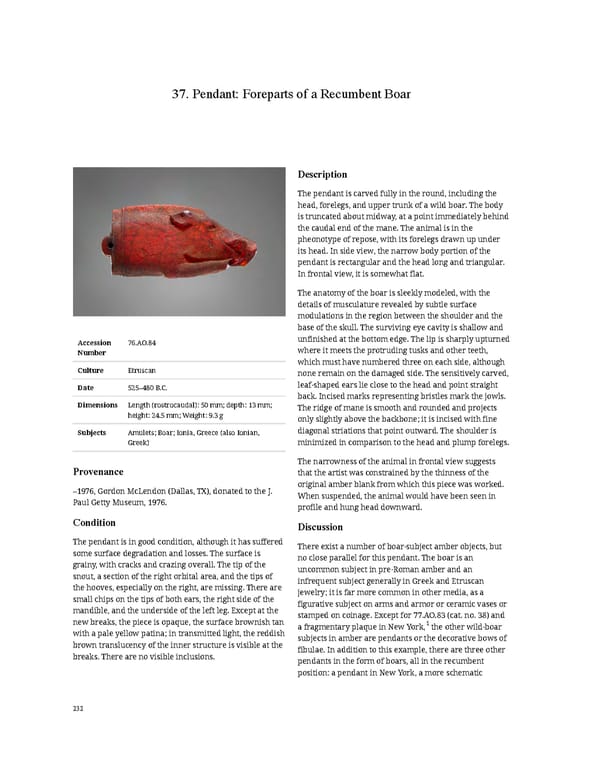37. Pendant: Foreparts of a Recumbent Boar Description The pendant is carved fully in the round, including the head, forelegs, and upper trunk of a wild boar. The body is truncated about midway, at a point immediately behind the caudal end of the mane. The animal is in the pheonotype of repose, with its forelegs drawn up under its head. In side view, the narrow body portion of the pendant is rectangular and the head long and triangular. In frontal view, it is somewhat flat. The anatomy of the boar is sleekly modeled, with the details of musculature revealed by subtle surface modulations in the region between the shoulder and the base of the skull. The surviving eye cavity is shallow and Accession 76.AO.84 unfinished at the bottom edge. The lip is sharply upturned Number where it meets the protruding tusks and other teeth, which must have numbered three on each side, although Culture Etruscan none remain on the damaged side. The sensitively carved, Date 525–480 B.C. leaf-shaped ears lie close to the head and point straight back. Incised marks representing bristles mark the jowls. Dimensions Length (rostrocaudal): 50 mm; depth: 13 mm; The ridge of mane is smooth and rounded and projects height: 24.5 mm; Weight: 9.3 g only slightly above the backbone; it is incised with fine Subjects Amulets; Boar; Ionia, Greece (also Ionian, diagonal striations that point outward. The shoulder is Greek) minimized in comparison to the head and plump forelegs. Provenance The narrowness of the animal in frontal view suggests that the artist was constrained by the thinness of the –1976, Gordon McLendon (Dallas, TX), donated to the J. original amber blank from which this piece was worked. Paul Getty Museum, 1976. When suspended, the animal would have been seen in profile and hung head downward. Condition Discussion The pendant is in good condition, although it has suffered There exist a number of boar-subject amber objects, but some surface degradation and losses. The surface is no close parallel for this pendant. The boar is an grainy, with cracks and crazing overall. The tip of the uncommon subject in pre-Roman amber and an snout, a section of the right orbital area, and the tips of infrequent subject generally in Greek and Etruscan the hooves, especially on the right, are missing. There are jewelry; it is far more common in other media, as a small chips on the tips of both ears, the right side of the figurative subject on arms and armor or ceramic vases or mandible, and the underside of the left leg. Except at the stamped on coinage. Except for 77.AO.83 (cat. no. 38) and new breaks, the piece is opaque, the surface brownish tan a fragmentary plaque in New York,1 the other wild-boar with a pale yellow patina; in transmitted light, the reddish subjects in amber are pendants or the decorative bows of brown translucency of the inner structure is visible at the fibulae. In addition to this example, there are three other breaks. There are no visible inclusions. pendants in the form of boars, all in the recumbent position: a pendant in New York, a more schematic 232
 Ancient Carved Ambers in the J. Paul Getty Museum Page 241 Page 243
Ancient Carved Ambers in the J. Paul Getty Museum Page 241 Page 243